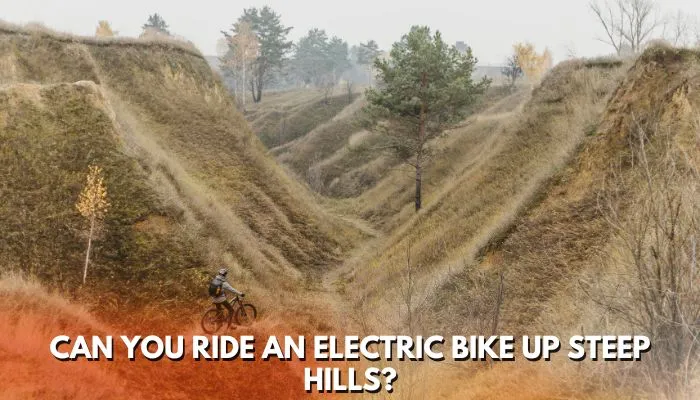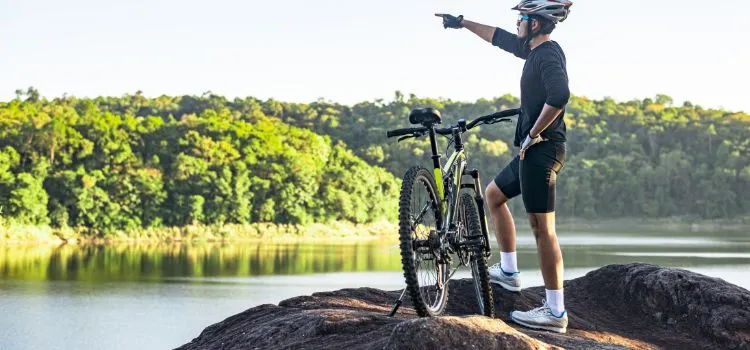Can You Ride An Electric Bike Up Steep Hills?

All across the world, electric bikes are becoming more and more common. They might be an excellent way to get some exercise, lessen your environmental impact, and get through traffic on your commute all at once. In addition, they provide some mechanical support to lessen the strain of carrying bigger weights over longer distances and up inclined slopes when compared to pedal power individually.
Table of Contents
Short Answer
Can electric bikes climb steep hills? They can; however, how effectively they manage the hardest hills depends depend on the motor’s kind and size. Other variables are going to be taken into consideration, such as the rider’s total body weight and any extra challenges. When you are aware of the typical tasks you anticipate completing, you can construct or purchase an electric bike that is appropriate for the job.
Suppose you’re considering purchasing an electric bike but live in a mountainous location or expect to utilize your bike on travels and want a thing that is capable of withstanding a thing. In that case, you should absolutely take those factors into consideration. Although any electric bike will complement the power you exert with your pedals, only a few models will be able to handle the toughest hills.
Can Electric Bikes Climb Steep Hills?
Extremely steep hills are no match for electric bikes, which can easily ascend them. This is not to say that electric bikes are completely capable of climbing slopes. Your electric bike’s capacity for solo climbing will be influenced by a variety of elements, which we’ll go into more depth about shortly.
Your own human effort is a significant aspect that you can manage. When that comes to moving your bike up a steep hill quickly, even a fair bit of pedaling power can go quite a distance. The motor of your electric bike will run much more efficiently with a little extra energy from your feet, regardless of the sort of bike you have.
This is not to argue that electric bikes are unable to ascend slopes with just the throttle power. In actuality, it’s almost entirely the opposite. Many electric bicycles equipped with throttles can ascend hills with an incline of 12 degrees or higher without the use of any human effort.
Even with these strong bikes, however, you’ll climb far faster if you put in somewhat bit of pedaling, even if you do so gently and without exerting a great deal of effort.
Is It Difficult To Climb Hills On Electric Bikes?

Steep hills can be challenging to drive on a regular bike, but an electric bike or an e-bike can make hill climbing much easier.
The motor on an electric bike provides pedaling assistance that can help overcome the extra resistance you face going uphill. With an electric bike, you can easily climb hills with lesser effort than on a normal bike, even if it is a steep or long hill.
The assistance delivered by the electric bike motor relies on the power of the bike motor and the type of assistance you select. The majority of electric bikes have different levels of assistance that you can modify to match the surrounding terrain and your own level of force.
You can enhance the assistance on steeper hills to make it easier to pedal. While on smoother terrain, you can reduce the assistance to get more maneuverability.
However, it is important to note that climbing hills on an electric bike can still be demanding, especially if the hill is steep or long. Even with electric assistance, you will still have to pedal and use your body muscles to power the bike.
In addition, the battery life of an electric bike can be influenced by hill climbing, as it demands more power from the motor to achieve additional resistance. Therefore, you may have to plan your route and charge stops accordingly if you plan to ride on lots of hills.
Elements That Affect Climbing On Steep Hills With An Electric Bike
Climbing up inclined hills with an electric bike can be hard, and there are different factors that can influence your ability to do so. Here are some of the major key factors:
- Motor power:
The bike power of the electric motor is one of the most essential factors in determining how well your electric bike climbs hills. A more potent motor will be able to deliver extra torque and help you in pedaling uphill.
- Battery capacity:
The capability of your e-bike battery will indicate how far you can ride on one charge, but it will also affect your capability to climb hills. Inclines require much more power, which will drain your battery much faster.
- Body weight of the user and cargo:
The body weight of the bike rider and any cargo they are carrying will affect the electric bike’s capability to climb hills. Bulkier loads will need more power from the bike motor, and this can easily drain the battery more quickly.
- Gearing ratio:
The gearing ratio of your electric bike will impact your ability to climb hills. A lower gearing ratio will have more torque and make it easy to pedal uphill. At the same time, a greater gearing ratio will allow you to achieve a higher speed on flatter terrain.
- Tire pressure:
The bike tire pressure can also affect your electric bike’s ability to climb steep hills. If the tires are under-inflated, it will enhance rolling resistance, which will make it even harder to pedal uphill.
- Gradient of the hill:
The steeper the hill, the more challenging it will be to climb. Even with a potent motor and a charged battery, steep hills may need you to put in extra effort than you would on flatter terrain.
- Pedaling effort:
While an electric bike can provide assistance, you still need to pedal to make it up a hill. The effort you put into pedaling the bike will affect how well your electric bike climbs hills.
Overall, the power of the motor and the capacity of the bike’s battery are crucial factors in indicating how well an electric bike can go uphills. However, some other factors such as weight, gearing ratio, tire pressure, and gradient of the steep hill also play a critical role.
Do Motor Types Have An Influence On Hill Climbing?

Yes, the motor type of an electric bike can make a significant difference in how well it can climb hills. There are different types of electric bike motors, each with advantages and disadvantages in uphill performance. Here are the most common motor types and how they influence hill climbing:
- Hub motor:
A hub motor is fixed in the center of the electric bike’s front or back wheel. These motors are less costly and simpler than other types and work well on smooth terrain. However, they may find climbing hills challenging as they provide lesser torque and may overheat if pushed too hard.
- Mid-drive motor:
A mid-drive motor is mounted in the middle of the bike frame, close to the pedals. This motor delivers more torque and power than a hub motor and is eventually better at climbing hills.
With a mid-drive motor, the electric assistance is provided through the bike’s chain, allowing the motor to be benefitted from the bike’s existing gears. This means that you can shift to a smaller gear when climbing hills, enabling the motor to provide much more power.
- Direct-drive motor:
A direct-drive motor is identical to a hub motor but is intended to provide more power and energy. These motors are larger and bulkier than hub motors, and they can be more costly. Direct-drive motors can be perfect at climbing hills, but they might not be as efficient as mid-drive motors.
- Geared hub motor:
A geared hub motor is identical to a direct-drive motor but has internal gearing that provides much more torque and power. These motors are more efficient and can be remarkable at climbing hills. However, they can be more heavy on the pocket than other motor types.
Ultimately, an electric bike’s motor type can significantly affect its hill-climbing power and performance. A mid-drive motor is generally considered a perfect option for climbing hills, as it delivers the most torque and can take advantage of the bike’s gears. However, all motor types can be effective at climbing hills, depending on their power output and the ground you are riding on.
Conclusion:
All in all, now you know you can electric bikes climb steep hills. Yes, they can eventually drive on steep hills. However, you must take into account some factors that can significantly influence how efficiently you climb up hills. Finally, now you can take out your electric bikes and successfully climb steeper hills.
